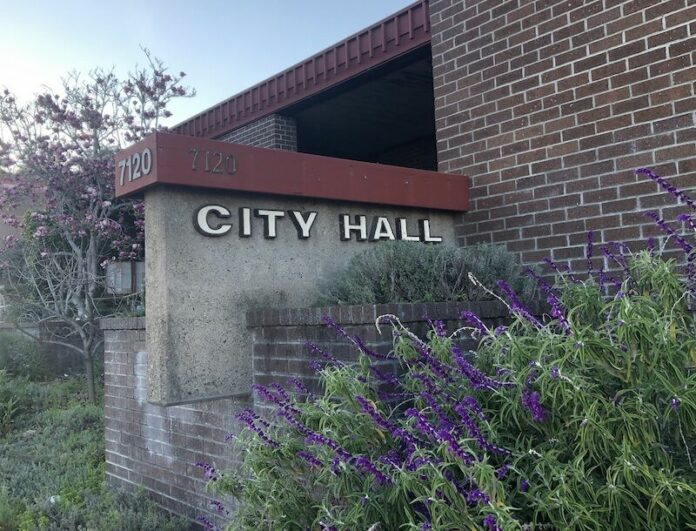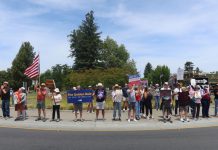The city of Sebastopol united with 700 other agencies, nonprofits and electeds to advocate for bolstering state action on climate change at the March 2 city council meeting by passing a resolution to endorse the Climate-Safe California campaign’s goals
The council’s unanimous vote of approval also meant adopting the campaign’s goals, according to the resolution.
Councilmember Diana Rich said that while the city already pledged to achieve carbon neutrality by 2030 in alignment with the Sonoma Climate Mobilization strategy, the Climate-Safe California platform seeks net-negative carbon emissions by 2030 and to be 80% under the city’s 1990 greenhouse gas emission levels by 2022, building equity into its policy approach.
Those policies to reach where Climate-Safe California wants to be in 2030 need to be established by 2025, she said. “And hey, it’s 2021, so this is moving fast down the runway, hitting the ground running.”
The Climate Center in Santa Rosa and the Local Government Commission from Sacramento lead the campaign with a platform that won the support of the Sebastopol Climate Action Committee and the Sonoma County’s Regional Climate Protection Authority (RCPA) board’s endorsement, according to Rich and the agenda report.
Former Sebastopol mayor Larry Robinson presented the campaign’s platform as the Climate Center’s director. Rich and Vice Mayor Sarah Glade Gurney requested the council’s endorsement, both seated on the Climate Action Committee while Gurney also serves as liaison between the city and the RCPA and Sonoma County Transit Authority, the agenda report said.
Robinson said that although Sebastopol and its citizens have continuously led the way in climate action, “there’s only so much that our individual efforts can do to bend the curve.”
The Climate Center director added, “And why your endorsement is so important is that our elected representatives in Sacramento, our state senators and assembly members look to you, really, to indicate what their constituencies are thinking and feeling and valuing.”
Getting down to business: three main principles, four main policies
Robinson said former Gov. Jerry Brown’s carbon neutrality target year of 2045 might have been the strongest political move possible back then. “But we’re facing a situation now where political viability has to take second place to what is necessary.”
The first of three principles guiding the way to carbon negativity that Robinson discussed was to drive legislative measures using the latest science, since climate scientists had previously underestimated the speed and totality of climate change.
Another principle was to see to a “just transition” for communities working in the fossil fuel industry, and third, to “prioritize climate justice,” so fossil fuel impacts stop hitting communities of color and lower income the hardest, as well as making climate solutions accessible.
The four platform pillars for net-negative emissions by 2030 are to wean off fossil fuel faster, sequester more atmospheric carbon, “invest in community resilience” and secure the funding for climate action, he said.
Speeding up the fossil fuel phase-out means stopping new oil and gas drilling, capping old wells, achieving decentralized electricity and energy storage without greenhouse gases by 2030, Robinson said, “to ensure that all of our transportation is greenhouse gas free, to ensure that our electrical grid is greenhouse gas free and that we are electrifying all of our buildings in California.”
As for capturing more carbon from the air, he said “the best way to do that is by changing our farming and land use practices and protect our habitat.” Drawing down 100 million metric tons more carbon dioxide was one goal listed in his presentation, along with habitat restoration and carbon farming and gardening.
The campaign’s ambition of building community resilience involves getting lower-income communities “clean-energy community microgrids with battery storage” by 2021 and getting resilience plans financed and established in every county and city in the state, according to Robinson’s presentation.
“And as those of us in the North Bay are well-aware, our electrical grid is not nearly as resilient as it can be, as it needs to be, as we found out in the last two major fires when the grid was shut down for safety reasons,” he said.
Senate Bill 99 presenting the Community Energy Resilience Act of 2021 and Assembly Bill 1325 for a community microgrid incentive program are proposals to look out for, he said.
Robinson said that “we need a distributed energy grid and we need microgrids that allow communities to maintain their vital services, even when the rest of the grid is in flux.”
Addressing climate change costs money that the Climate-Safe California campaign suggests raising by “opening up the markets to private investments,” and charging passengers $10 per flight in all California airports, he said.
Without going into further detail, Robinson said the frequent flyer fee would drum up about $2.5 billion by changing $10 for 240 million annual flights in the state “to invest in our local communities.” Making changes to the tax code and closing tax loopholes is another strategy, according to the presentation.
“We need progressive carbon taxes, we need clean climate bonds. California is the only oil-producing state that does not charge an oil severance tax, it does not tax the extraction of fossil fuels. We can do that,” he said, adding, “that we hope to be in a bill before the legislature before next year.”
Altogether, the campaign seeks to raise between $12 billion and $20 billion annually through various funding approaches, according to Robinson’s presentation.
Mayor Una Glass calls for putting full support behind the campaign
Robinson shared Congressman Jared Huffman’s statement endorsing the Climate-Safe California campaign and said the Sebastopol City Council’s support would ultimately help advance “a whole suite of policy proposals” the campaign plans to put forward in the coming three years to achieve 2030 carbon negativity.
Robinson introduced Jane Bender as a colleague, who thanked the council for adding its voice for the state legislature to hear.
“But I really do want to remind you this is going to be a battle,” she said. “This is going to be a lot of work because, unfortunately, California has made their money off the fossil fuel industry for years and years and years.”
During public comment, one community member who often attends city council meetings to raise concerns about wireless radiation said more research was needed on the effects of electricity and magnetic fields on biology, like cancer, regarding electricity in all buildings.
Laura Goldman said she was proud to belong to the Sebastopol community with the council’s leadership and invited them to talk further on her radio show.
Glass said the city needs to do everything in its power to back the campaign and get the state government to act.
“I think climate protection or mitigating the climate situation is literally the existential issue of our time. It’s actually bigger than COVID. Although we’re all stuck here in COVID land, which seems more immediately direct to us, climate change is a little more subtle because it’s so big,” she said.









